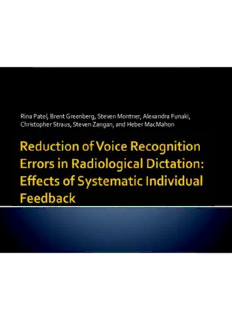
Rina Patel, Brent Greenberg, Steven Montner, Alexandra Funaki, Christopher Straus, Steven ... PDF
Preview Rina Patel, Brent Greenberg, Steven Montner, Alexandra Funaki, Christopher Straus, Steven ...
Rina Patel, Brent Greenberg, Steven Montner, Alexandra Funaki, Christopher Straus, Steven Zangan, and Heber MacMahon ¡ Versions of voice recognition software have been used to generate radiology reports since the late 1980s1; though this early software was limited in its uses, accuracy, and report generation time ¡ Advances in voice recognition software have decreased turnaround times for final reports and increased productivity § A recent study showed improvement in report turnaround time from 28 hours to 12.7 hours, with an associated 5% increase in volume of reports dictated2 ¡ Although turnaround time is important, accuracy of the report is a primary concern ¡ Thus, error rates with voice recognition software are still a major issue § A recent study of MRI reports found that 30 to 42% of voice recognition reports contained errors, compared to 6 to 8% of transcriptionist reports3 ¡ Prior to voice recognition software, radiologists used transcriptionists or word processers to generate reports ¡ Radiologists dictated reports that were sent to a medically trained transcriptionist or staff typist, the transcribed report was then sent back to the radiologist for review and finalization ¡ Turnaround times were up to 24 hours or greater for finalization of reports § Long turnaround times are a detriment to the ordering physician, who often relies on immediate image interpretations § Long turnaround times also make it difficult for the radiologist to accurately review and revise the final report ▪ The delay of 24 hours, makes it difficult for the radiologist to remember the images and original dictation when finalizing the transcription ▪ Thus, simple word substitutions by the transcriptionist may easily be missed ¡ The development of voice recognition technology was of great interest to radiologists, as it could potentially improve turnaround time and increase work flow efficiency ¡ Reports of the use of voice recognition software in radiology are published as early as the late 1980s1 ¡ Earlier versions of voice recognition software were limited to Navigation and Discrete Dictation programs § Speech recognition software used for “Navigation” is limited to commands that control an application § “Discrete dictation” systems identify each individual word that is spoken; thus requiring the speaker to pause between each word so that the computer can identify that word4 ¡ Later software used Continuous Dictation systems § With continuous systems, users can speak at a natural pace § When spoken at a natural pace, words are blurred together and the acoustics of each word changes depending on the preceding and subsequent words4 ¡ Understanding how voice recognition software works is important to understanding the common errors associated with this technology § Speech is converted to text based on vocabulary and language models ▪ Vocabulary models match the acoustics of the spoken word with a word in a pre-defined dictionary ▪ Language models assist the vocabulary models by picking words that are more likely to occur in that part of the sentence4 ¡ Errors with voice recognition software occur when the acoustics of the spoken word do not match the vocabulary dictionary § For example, ambient noise or mispronunciation of a word changes the acoustics of a word § As mentioned, continuous speech changes the acoustics of individual words due to effects from the preceding and subsequent words ▪ Thus, vocabulary dictionaries must recognize multiple acoustic versions of a single word ¡ Voice recognition software is unable to recognize every potential pronunciation of a particular word; thus creating potential errors in reports ¡ Reported frequency of voice recognition error rates in the 3,5-8 radiology literature ranges from 4.8-42% ¡ Uncorrected errors have potentially serious consequences § Some errors are minor (e.g. grammatical errors) or are easily recognized by the ordering physician as an error § Other errors can be confusing or misleading and alter the meaning of the report ¡ Whether errors are major or inconsequential, they can be embarrassing evidence of careless proofreading and have potential medicolegal consequences ¡ Voice recognition software was implemented at University of Chicago in September 10, 2007 ¡ The software currently in use is Nuance RadWhere for Radiology, which includes Dragon NaturallySpeaking by Nuance Communications ¡ Although this technology has been used for many years at our institution, the frequency of errors associated with voice recognition software has not been formally documented ¡ Furthermore, programs to address voice recognition errors are not commonly employed ¡ The purpose of this study was to implement a quality improvement initiative in the Chest section of the University of Chicago Radiology department to address the frequency of voice recognition errors and reduce the number of errors in the final report
Description: